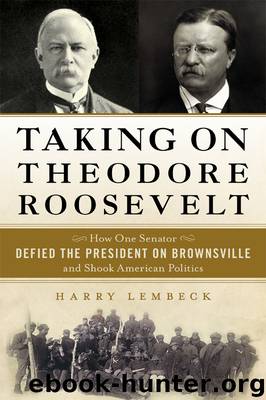Taking on Theodore Roosevelt by Harry Lembeck

Author:Harry Lembeck [Lembeck, Harry]
Language: eng
Format: epub
ISBN: 9781616149550
Publisher: Random House Publisher Services
Published: 2014-12-02T00:00:00+00:00
“I am perfectly satisfied that no man in the Battalion fired a shot.”
Senator Joseph Foraker in a letter to
Lieutenant Colonel Edwin F. Glenn,
defense counsel for Major Charles Penrose,
February 7, 1907
AT 10:30 A.M., MONDAY, February 4, 1907, Senator Francis E. Warren brought the Senate Military Affairs Committee to order to begin its investigation of the Brownsville Incident. Over the next thirteen months—with a four-month break in the summer and fall of 1907—its members heard testimony from soldiers, civilians, investigators, and experts; read testimony from other hearings and trials; ordered sophisticated testing of rifles and other weapons, bullets, and shells found on the ground in Brownsville or dug out of walls, rooms, and trees; and endlessly discussed their differences. Its transcripts without exhibits are 3,411 pages long. When the committee issued its reports on March 11, 1908, nine senators—half its Republicans and all its Democrats—supported President Roosevelt's discharges.1 In his memoirs Foraker would write, “All of [the Democrats on the committee] were against the Negroes before a word of testimony was heard,” and enough of the Republican members would join with them to make a majority.2 It claimed the evidence “clearly established” that the soldiers had shot up the town, but exactly which ones was still a mystery.3
Four Republican committee members, Senators Foraker, James A. Hemenway of Indiana, Morgan G. Bulkeley of Connecticut (who would sit with Joseph Foraker when he received the loving cup a year later), and Nathan Scott of West Virginia, who had stood by Foraker and defended the soldiers early in the Senate debates, disagreed with the committee's majority and said the case against the soldiers had not been proved. Their minority report said the testimony, “as thorough as it was possible to obtain,” was nevertheless “very unsatisfactory, indefinite, and conflicting.” It failed to show a motive for the soldiers to shoot up the town. Other persons, the owners of “eight gambling houses” who would not permit the black soldiers to come into their casinos and saloons and wanted the white troops back to recapture the wagering losses and bar bills that made their business so profitable, had better reasons to do it.4 And all of the battalion's white officers believed the soldiers were innocent.5 “Beyond a reasonable doubt…many of the men so discharged were innocent of any offense.” Foraker and Bulkeley went a step further and flatly added to the minority report that “none of the soldiers participated in the shooting.” In other words, all were innocent. They would submit an exhaustive seventy-four page memorandum justifying this position.6
In his almost 1,100-page memoirs, Senator Foraker devoted only thirty-four words to these hearings.7 This may reflect regret was his lasting frustration. But in fact, he performed magnificently for the soldiers. The Senate committee was the wrong venue, and his skills as a lawyer were wasted.8 He discredited testimony against the soldiers; committee members were unmoved. Katie Leahy said she saw from her window the soldiers shooting into the town from the Company B barracks. But she could not have. Foraker showed through Lieutenant Harry Leckie that a tree blocked her view.
Download
This site does not store any files on its server. We only index and link to content provided by other sites. Please contact the content providers to delete copyright contents if any and email us, we'll remove relevant links or contents immediately.
| Anthropology | Archaeology |
| Philosophy | Politics & Government |
| Social Sciences | Sociology |
| Women's Studies |
Cecilia; Or, Memoirs of an Heiress — Volume 1 by Fanny Burney(32081)
Cecilia; Or, Memoirs of an Heiress — Volume 3 by Fanny Burney(31471)
Cecilia; Or, Memoirs of an Heiress — Volume 2 by Fanny Burney(31425)
The Great Music City by Andrea Baker(30809)
We're Going to Need More Wine by Gabrielle Union(18649)
All the Missing Girls by Megan Miranda(14810)
Pimp by Iceberg Slim(13809)
Bombshells: Glamour Girls of a Lifetime by Sullivan Steve(13706)
Fifty Shades Freed by E L James(12930)
Talking to Strangers by Malcolm Gladwell(12906)
Norse Mythology by Gaiman Neil(12868)
For the Love of Europe by Rick Steves(11596)
Crazy Rich Asians by Kevin Kwan(8905)
Mindhunter: Inside the FBI's Elite Serial Crime Unit by John E. Douglas & Mark Olshaker(8727)
The Lost Art of Listening by Michael P. Nichols(7179)
Enlightenment Now: The Case for Reason, Science, Humanism, and Progress by Steven Pinker(6885)
The Four Agreements by Don Miguel Ruiz(6330)
Bad Blood by John Carreyrou(6286)
Weapons of Math Destruction by Cathy O'Neil(5856)
